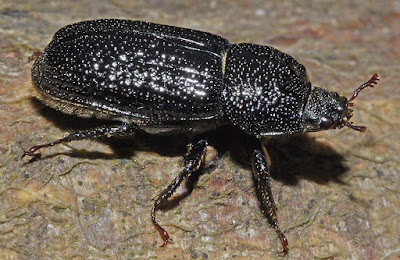Thursday, July 2, 2015
The Teesdale Rhino
Thursday's Guardian Country Diary is about this little beetle.
We have log piles all around the garden, where the remains of trees that have grown here in the past and are slowly rotting away play host to all sorts of insects. In amongst the logs there's holly, hornbean, whitebeam, cherry, walnut, plum, ash and several different conifers. If they had all been left to grow to full size our small garden would have become a dense forest.
My wife found this beetle in one of the log piles and since I couldn't identify it I posted a couple of photographs on the wonderful iSpot web site.
Within a few days it had been identified by Darren Mann, coleopterist at Oxford University Museum of Natural History, as a female rhinoceros beetle, Sinodendron cyclindricum. Unlike the male of the species, she doesn't have a rhinoceros-like horn on her nose but a few days later we found a mate for her in a grove of beech trees in Teesdale.
At the time we had no idea what we had found because the beetle had been crawling under loose bark and its head was covered in spiders' webs. It looked like another female but when we took it home to clean it up, gently removing its entanglements, it .....
... revealed this magnificent rhino horn, tipped with a brush of ginger hairs.
From this angle that flat, plate-like front to the thorax reminds me of the dinosaur Triceratops.
This beetle is about the length of my thumbnail.
So what does it use that horn for? It can't be feeding, otherwise surely the female would have one too. Apparently they feed on tree sap.
It must be sexual ornament. It would be good to put two males together and see if they use it as some sort of weapon in a contest for females.So that's my next move - to try to find more and see how they interact.
Meanwhile this male has joined the female in the wood pile, where I hope they are breeding.
Subscribe to:
Post Comments (Atom)































An Excellent find times two.
ReplyDeleteVery lucky!
DeleteWhat a wonderfully strange thing you found! Will have a little rummage in my so called garden when I get home
ReplyDeleteGardens are full of surprises, aren't they?!
DeleteThe ginger hair makes it all the more attractive!
ReplyDeleteI wonder what it's for?
DeleteThis comment has been removed by the author.
ReplyDeleteI always found that fellow naturalists are incredibly generous with the time and expertise, Kate.
Delete